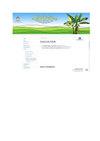The effect of infestation with rice water weevil (Helodytes foveolatus Duval) on the growth and development of rice (Oryza sativa L.) in Guyana
IF 0.2
Q4 AGRONOMY
引用次数: 0
Abstract
Rice ( Oryza sativa L.) production, the largest agricultural sub-sector in Guyana, is greatly affected by insect pests. The rice water weevil ( Helodytes foveolatus Duval) is an early-season pest of rice at both the adult and larval stages with the latter resulting in the greater yield loss. This study compared the growth and development of rice plants subjected to varying levels of water weevil larvae infestation. Plants were infested with 3, 5, and 7 larvae/plant at two periods: 18 and 30 days after sowing (DAS). Uninfested plants served as the control. Each treatment was replicated five times and plant height, tiller count, panicle emergence and panicle density were recorded. Results showed that there were significant differences in plant height at maturity and throughout the trial, for infestation treatments applied at 18 and 30 DAS. At maturity, a similar trend was observed in the number of tillers produced by the various treatments; plants infested at 18 and 30 DAS with 7 larvae/plant had significantly lower number of tillers than the control and plants infested with 3 and 5 larvae/plant (P=0.03 and P=0.02) respectively. Panicle emergence and panicle density were also influenced by the number of water weevil larvae per plant and the length of time of infestation. This study proves that growth and development of rice plants can be affected by the level of infestation and the time of infestation of rice water weevil larvae. This can be useful in determining the amount of damage caused by the pest and therefore indicate to farmers whether or not control measures should be applied.水稻水象甲(Helodytes foveolatus Duval)对圭亚那水稻生长发育的影响
水稻(Oryza sativa L.)生产是圭亚那最大的农业子部门,受到害虫的严重影响。水稻水象甲(Helodytes foveolatus Duval)是水稻成虫和幼虫期的早季害虫,后者导致更大的产量损失。这项研究比较了水稻植株在不同程度的水象甲幼虫侵扰下的生长发育情况。在播种后18天和30天(DAS)的两个时期,用3、5和7只幼虫/株感染植物。未经试验的植物作为对照。每个处理重复5次,记录株高、分蘖数、穗出穗率和穗密度。结果表明,对于18和30 DAS的虫害处理,在成熟期和整个试验期间,植株高度存在显著差异。成熟时,在不同处理产生的分蘖数量上也观察到类似的趋势;以7个幼虫/株的18和30DAS感染的植株的分蘖数分别显著低于对照和以3和5个幼虫/植株感染的植株(P=0.03和P=0.02)。每株水象幼虫的数量和侵扰时间的长短也会影响穗部出苗和穗部密度。本研究证明,水稻植株的生长发育会受到稻水象甲幼虫侵扰程度和侵扰时间的影响。这有助于确定害虫造成的损害程度,从而向农民表明是否应该采取控制措施。
本文章由计算机程序翻译,如有差异,请以英文原文为准。
求助全文
约1分钟内获得全文
求助全文
来源期刊

Tropical Agriculture
Social Sciences-Development
CiteScore
0.50
自引率
0.00%
发文量
0
期刊介绍:
The overarching aim of Tropical Agriculture is to contribute to the process of agricultural development in tropical agro-ecosystems, through publication of papers in the area of agricultural science and technology. The specific objectives of the Journal are: -To address the practical aspects of sustainable tropical agriculture production, improvement, protection and commodity utilization, worldwide. -To foster the application of science and technology to understanding and removal of constraints to tropical agricultural productivity. -To publish the results of original research which make significant contributions to knowledge on the practice of sustainable and productive tropical agriculture. The Journal publishes papers in the following areas of tropical agriculture: -Soil Science and Technology -Environmental Science and Technology -Crop Science and Technology -Livestock Science and Technology as well as: Food and Nutrition Policy, Post-Harvest Technology, Agricultural Economics and Extension, Agribusiness
 求助内容:
求助内容: 应助结果提醒方式:
应助结果提醒方式:


